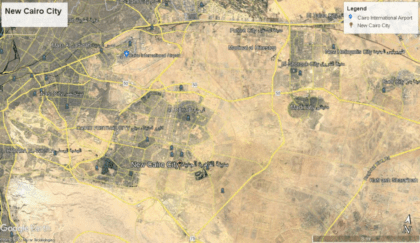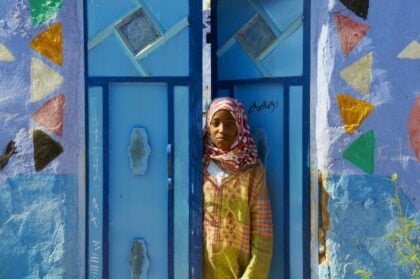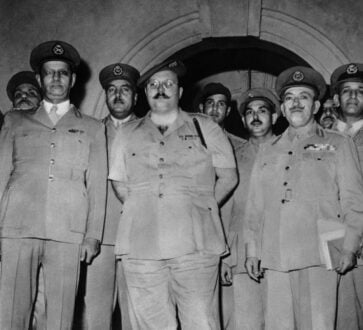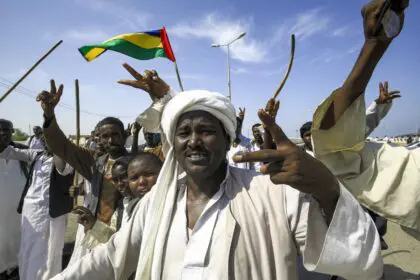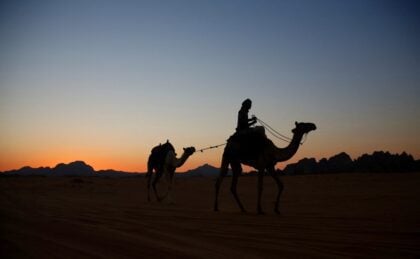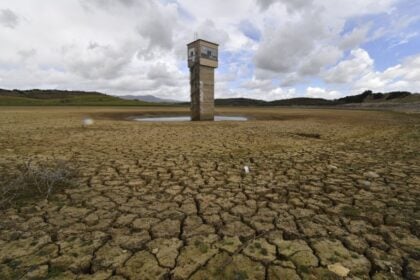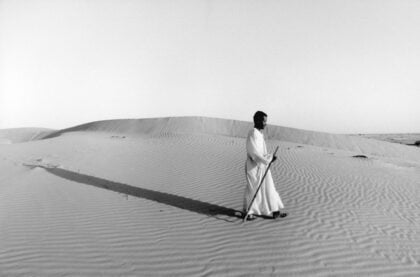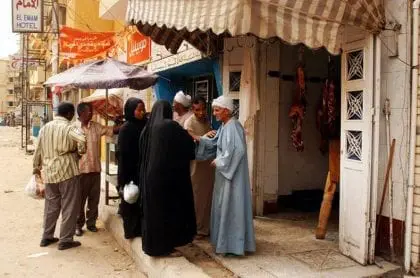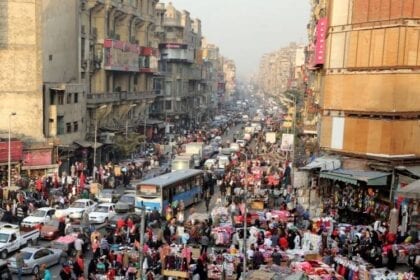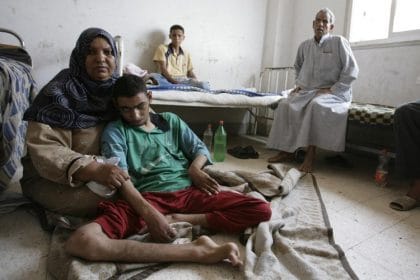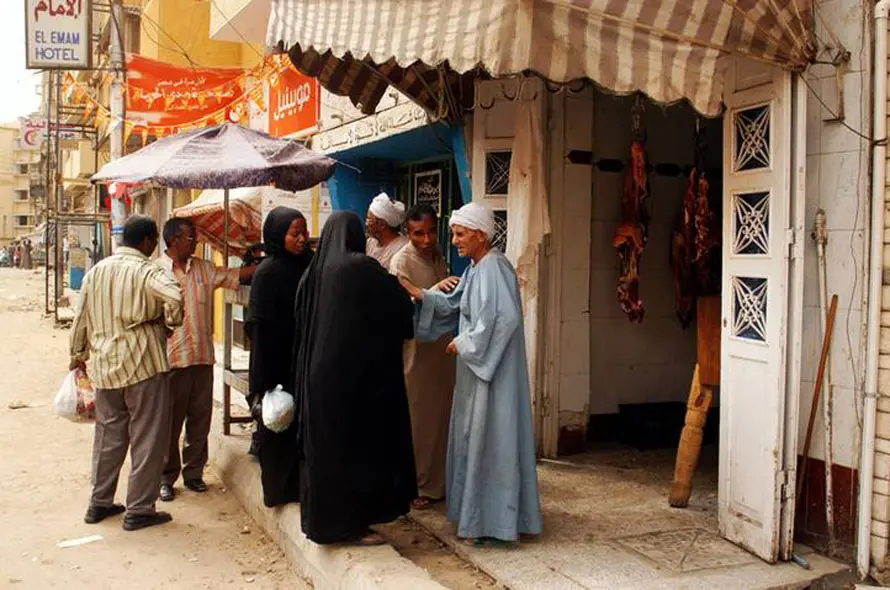
Introduction
The population of the Arab Republic of Egypt reached about 114 million people at the beginning of 2024, according to data from the United Nations Population Fund (UNFPA). A 1.57% increase from 2023.
The percentage of males reached 50.6% of the total population, compared to 49.4% for females, with a sex ratio of 102 males for every 100 females.
The number of families in Egypt reached 23.24 million. The average family size in rural areas is 4.2, compared to 3.9 in urban areas, which indicates a steadiness in the average family size in Egypt
The data also showed an increase in the population from 59.2 million in 1996, to 72.6 million in 2006, then to 94.8 million in April 2017. This means that the annual growth rate has increased from 2.04% during 1996-2006, and 2.56% during 2006-2017, to 2.02% during 2017-2024.
Most Egyptians are Sunni Muslims, in addition to a Shiite minority of less than a million, according to most of the estimates.
Islam is the religion of the state and its principal source of legislation according to the different constitutions of Egypt, since 1923 constitution (Article 149), until the current constitution of 2014 (Article 2), except 1930 constitution, which was in force until 1954.
Christianity (Coptic Orthodox, Catholic, and Protestant) is the second biggest religion in Egypt. Despite the absence of any official data, prominent religious sources estimated their number in 2023 at 15-18 million, according to church care visits and the Pope’s declaration.
Egypt is also home to other religious minorities like Baha’i (thousands), and Judaism (tens), according to unofficial estimates.
Some ethnic minorities, which settled in Egypt throughout history, are still clinging to their historical roots, cultural heritage, and social traditions, like Bedouins, Nubians, Amazigh, and Beja.
Age Groups
Egyptian society is considered youthful, like the age group of under 15 accounts for more than one-third of the population with a percentage of 32%, according to UN 2024 estimates. While only 5% are over 65. And the age group 13-34 accounted stood at 36.3% of the total population. This high percentage of youth leads to problems in the labor market and social services.
Despite the government’s efforts in awareness campaigns to control the overpopulation, the last years have seen a steady decrease in fertility rate, which stood at 2.6 births per woman in early 2024, compared to 3 births per woman in 2019.
In 2024, the average life expectancy stood at 75 years (73.8 for males and 76.2 for females).
Areas of Habitation
Egypt has the largest population in both the Middle East and North Africa. And it’s ranked 13th among the most populous countries in the world.
In 2020, the population density reached 99 people/km2, compared to 92.4 people/km2 in 2017. The capital, Cairo, is the largest Egyptian governorates in terms of population density, with 9.9 million, followed by Giza with 9.09 million, then Al Sharqiya and Al Daqahliya with 6.8 million and 7.6 million respectively.
Only 7.84% of the total land area along the Nile and its delta is cultivated and populated. And more than 97% of the population live on that narrow strip.
Data indicate that nearly one-third of the population reside in the rural areas of Lower Egypt, while 25.4%reside in the rural areas of Upper Egypt.
Minorities

Aswan, Photo Shutterstock.
Some ethnic minorities that live in Egypt still honor their roots and different original traditions, such as Bedouins (in Western and Eastern Deserts, and Sinai), Nubians (in Upper Egypt and near to the southern borders), Amazigh (in Siwa Oasis in the Western Desert and near to the Egyptian-Libyan borders), and Beja (near to the Egyptian-Sudanese borders in the disputed territory of Halayeb Triangle, which is currently under Egyptian administration).
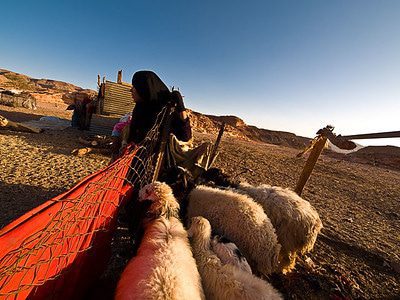
Bedouin
Some sources say that the presence of Bedouins in Egypt dates back to decades before Islam. Some tribes migrated from the Arabian Peninsula, such as the “Kahlan” tribe which settled in the northeast of Egypt, the “Bali” tribe which settled in Al Qoseir, “Khuza’a”, and other tribes. But regarding “ Lakhm” and “Khuzam ” tribes, the German orientalist Max Freiherr von Oppenheim and his colleagues Erich Bräunlich and Werner Caskel associate their migration with the Muslim conquest of Egypt in the mid-7th century, to settle in the Sinai Peninsula, which became the main incubator to most of the Bedouin tribes that settled in Egypt.
The Sinai Peninsula currently has nearly 11 tribes.Al-Sawarka tribe in North Sinai is the most famous, and it’s one of the largest tribes in Sinai. They reside in the area from Arish districts to Sheikh Zuweid in the north to the Airport in the west, and it has 13 clans or families.
The discrimination that has been imposed for long by successive regimes against Sinai made its people cling more to their habits and traditions such as the customary judiciary that prioritizes preserving lives, society, and money, and regulate all aspects of daily life in this area. That proved important under the British occupation of Egypt from 1882 to 1956, as the people of Sinai were not affected by their colonial ambitions. Also, they held on to their heritage and their land during the Israeli occupation of Sinai from 1967 to 1982. All of their disputes were resolved by local judges instead of going to the colonial authorities lest their treachery and to not give them the chance to take advantage of these disputes.
For long, Sinai Bedouins have expressed resentment against the marginalization and deprivation of fundamental civil rights since Israel’s withdrawal from the peninsula and returning it to Egypt in April 1982 according to the peace agreement signed in 1979, after the Jewish country occupied it in the wake of the Six-Day War.
The people of Sinai are suffering from unemployment, lack of development, services, and the infrastructure needed for development projects, despite being rich in natural resources such as minerals and natural gas. Not to mention that they’re not allowed to own land, and after Israel’s withdrawal, their youth are not accepted in the military.
Since the deposing of President Mohamed Morsi on 3 July 2013, the Egyptian state has been involved in continuous battles against terrorist groups that escalated their attacks in late 2017 against police and military forces, which led to hundreds of casualties.
In February 2018, the government launched a counter-terrorism campaign called “The Comprehensive Operation – Sinai 2018”, which is conducted by the Armed Forces and the Interior Ministry, targeting strongholds of the extremist groups related to Al-Qaeda and ISIS, and aiming to enhance the security and development in the Peninsula.
Nubian

On the banks of the Nile and south of the city of Aswan, located the area of Nubia or land of gold as called by the ancient Egyptians.
Nubia is a name derived from the word “Nub” which means “gold” in the ancient Egyptian language. It is famous for its gold mines, which were called “Nubria”.
According to a government census in the early 1960s, the number of Nubians in Egypt was 99,000, including 48,000 in Nubia and about 50,500 in other cities. The number of households residing in Nubia was 16,800, compared to 8.500 expatriate households. Currently, in the absence of official statistics, some sources estimated the number of Nubians in Egypt at about 3 million in 2011.
The Nuba area includes 38 villages and one city center. the Nubian village or city consists of a group of scattered dwellings, often located on one or both banks of the Nile and called “Hamlet”.
Nubians have a language of their own, “ Nubian language “, which is an unwritten language, in addition to the Egyptian dialect. They also speak English, French, and Italian as a result of mixing with tourists.
The history of the Nuba people is a series of successive sacrifices. Nubians were displaced from their villages because of the construction of the High Dam.
The first Nubian migration was with the construction of the reservoir of Aswan in 1902, during the reign of Khedive Abbas Helmy II, which caused the water level to rise behind the reservoir to sink 10 Nubian villages of Nubians. They emigrated voluntarily without the request of anyone to the western land villages and various governorates of Egypt.
When the first heightening of the Aswan reservoir took place in 1912, the water level rose again and drowned the other 8 villages: Qortha, Allaqi, Sayala, Mahraqah, Madeq, Saboa, Wadi Al-Arab, and Shatramah. Followed by the second heightening of the reservoir in 1933 which flooded another 10 other villages.
With the beginning of the studies to build the High Dam in the 1950s, the people of Nuba were deported behind the dam in 1963 to the Kom Ombo hill.
The migration of the Nubians had consequential issues that began with the census in 1960 that classified them as either residents or expatriates. 42 villages have been transferred with the same old names, health and educational units have been established and provided with facilities that did not exist in the old Nubia.
People now complain that their houses no longer suit them, especially as the children need new housing because each family has only a one-room or four-room house according to their number.
Recently, according to the 1.5 million Feddan Project, plots in Nuba were offered to be sold by public auction along with other lands, which angered the Nubians and made them demand to be prioritized by the government.
Nubian Demands
Nubians demand the current government to give priority to the people of Nuba and Aswan in the Toshka project within 1.5 million Feddan Project. Also, the activation of Article 236 of the Constitution to issue a law establishing the Supreme Commission for resettlement, reconstruction, and development of the original Nuba, and the amendment of the Presidential Decree No. 444 of 2014, on the determination of areas adjacent to the border, following the constitution and the rights of Nubians to resettle in their original territory. Also, to stop putting any projects for sale or auction to investors and businessmen in the region before the activation of the Constitution and the issuance of the law.
Amazigh
In Siwa Oasis of Marsa Matruh governorate, west of the Egyptian capital Cairo near the Libyan border, Amazighs of Egypt are concentrated. Their actual number is between 30 and 35 thousand, who still retain their customs, traditions, dialectics, rituals and still communicate with their branches in all African countries.
Anthropologists have different opinions about their origins. Some think that they have Greek origins and others think they have Indo-European origins. Also, there is a view that favors the double origin of the Amazigh. However, most studies favor the African origin of Amazighs.
The Egyptian woman called Amani Al-Washahi is the Vice-President of the World Amazigh Congress Organization, an international human rights NGO founded in Paris in 1995. Its membership includes all the Amazigh organizations, associations, and individuals active in the Amazigh Movement. The NGO aims to defend the political, economic, social, and cultural rights of Amazighs everywhere. The organizational structure consists of the Office of Trustees, the International Bureau, the Federal Office, and the local offices.
The Congress is the sole and legitimate representative of the Amazigh people before international organizations. It is currently headed by the Libyan Fathi Nakhlefa, and it has representatives in all the countries where Amazigh is present. These representatives are members of the International Bureau.
Amazighs came to Egypt 3000 years ago, through two waves of migration, the first in the reign of King Ramses III, and the second accompanied by the army of “Al-Mu’izz li-Din Allah Fatimid,” who decided to invade Egypt, and sent an army of 100 thousand troops led by Jawhar The Sicilian, most of the soldiers were of the Amazigh, specifically from the “Kutama” tribe.
The Amazighs ruled Egypt for 200 years, during which they founded three families: 22-23-24, the first is the 22nd family that ruled in the period between 950 and 817 BC, the 23rd family ruled between 817 – 730 BC, and the third Amazigh family Between 730 and 715 BC.
In 2014, the Amazigh participated for the first time in the drafting of the current Egyptian constitution, and their demands were summed up to preserve the Amazigh cultural component from extinction as a component of Egyptian culture.
The Amazigh does not see that the preservation of Amazigh culture can be an obstacle to integration into Egyptian society. Several Amazigh has emerged in Egypt who give to Egypt a lot and were examples of integration and adaptation, such as General Omar Suleiman, Mustafa Kamel, Mohammed Haidar Pasha, and the pioneer feminist Huda Shaarawi.
Beja
In the south-east of the Egyptian-Sudanese border, in the Halaib and Shalatin area and between the rugged mountain valleys, many tribes of the Beja tribe or the “Pharaohs fighters” – as rumored among them – stabilize and reside, distributed over the Red Sea coast southward to Eritrea and Ethiopia.
The British ethnologist Seligman confirms that the breed that inhabits the Eastern Desert of Egypt and Sudan is very similar to the proto-Egyptians, especially in Prehistoric Egypt, and they were able to preserve the purity of their descendants by isolating themselves in the desert.
Beja speaks an unwritten language called Cushitic, which is inherited from one generation to another, and it contains many Pharaonic words.
Seligman said that the Beja are the inheritors of the cultural, physical, and historical heritage of the Pharaohs. The Beja knew the Pharaohs since 4000 BC.
The demographic structure of Halaib, Shalatin, and Abu Ramad consist of the Beja tribe, which accounts for 60% of the population, and there is the tribe of Ababda, which is rooted to Abd Allah ibn al-Zubayr; the inhabitants of Halaib and Shalatin belonging to this tribe represent 35% of the population; the remaining 5% is a mixture of the Atman, Rashaida and Hadundo tribes.
In the parliamentary elections in 2015, Halaib and Shalatin constituency won its first seat in the history of the Egyptian parliament. The participation rate was 52% and it was the highest among the constituencies in Egypt. For the second time in a row, one of the candidates of the Halayeb and Shalateen regions – the candidate of the Republican Party – retained the district seat by winning the 2020 parliamentary elections.
In 2017, the fertility rate stood at 3.5 children per woman, compared to 2.9 in 2011. The government says it’s due to dropping out of education, early marriage, and the lack of employment opportunities for women.
Migration
The Ministry of Immigration and Egyptians Abroad Affairs estimates that the number of Egyptians abroad in 2020 is about 13 million Egyptians, Saudi Arabia is at the forefront with more than 2 million Egyptians. And an increase of 3.5 million Egyptians outside the country than their number in 2017.
According to the 2017 census, nearly 9.5 million Egyptians live outside the country, either temporarily, semi-permanently, or permanently. No surveys are determining the distribution of Egyptian migrants on different types of emigration. However, researchers believe that the agricultural nature and the bonding of Egyptians with their roots and land make them tend less to permanent emigration, as they don’t emigrate unless being under compelling circumstances.
The motives for the emigration of Egyptians in its different forms vary from seeking employment due to high unemployment rates to political persecution, and religious or ideological discrimination.
According to the records of the Egyptian Foreign Ministry, most of the Egyptian emigrants are concentrated in the Arab countries. By the end of 2016, they numbered about 6.2 million Egyptians constituting 65.8% of the total Egyptians abroad, The Americas come second with 1.6 million Egyptians or 16.7%, then the European countries come third with 1.2 million Egyptians or 13.2%, followed by Australia with 340 thousand or 3.6%.
In the census report announced by the CAPMAS, the historical development of the Egyptians’ emigration to the countries of the world was observed, which pointed out that in the early 1930s, the government sent delegations to the neighboring Arab countries to achieve developmental purposes in these countries. The Iraqi government was the first to ask for teachers to work there.
According to data from the latest census, Saudi Arabia was at the forefront of the countries where the Egyptians work with 2.9 million Egyptians by the end of 2016; Jordan came second with around 1.150 million Egyptians; The United Arab Emirates ranked third with about 765.000 Egyptians, followed by Kuwait, which has nearly half a million Egyptians, while the number of workers in Qatar was about 230.000 Egyptians.
Since 2016, The employment opportunities for Egyptian workers in the oil-rich Gulf states have declined by at least 70% due to political and economic disorders in the Gulf countries, low education levels, and the Egyptian labor being unqualified to meet the needs of foreign labor markets; Also, the Gulf countries resorted to importing low-cost Asian labor from Pakistan, India, and Bangladesh.
In the survey of Egyptians in European countries, they aggregately accounted for 1.249 million; Italy had the largest share with nearly 560.000 Egyptians, followed by France with 365.000, then Germany with 77.000, England with62.000,The Netherlands with 45.000, and nearly 2.000 Egyptians in Poland, 80 in Azerbaijan and 15 in Uzbekistan.
Africa accounted for the lowest number of Egyptians abroad with nearly 46.872 Egyptians, with South Africa alone accounting for 85% of them.
Regarding illegal immigration, international organizations consider Egypt as a transit country for trafficked persons and smuggled migrants, as well as a destination. The first routes for smuggling migrants who want to cross into Europe via Egyptian coasts start from the Horn of Africa and East Africa.
In 2016, Egypt adopted Act No. 82 of 2016 on countering illegal immigration and smuggling of migrants, which merged the National Coordinating Committee for Preventing and Combating Illegal Migration (NCCPIM) with the National Coordinating Committee for Preventing and Combating Human Trafficking. It also has Act No. 64 of 2010 regarding human trafficking. Both acts constitute a comprehensive legal framework to counter human trafficking and the smuggling of migrants.
Refugees

An Egyptian and Palestinian flags in the streets together in the 2011 uprising.
According to the Egyptian President Abdel Fattah al-Sisi in his speech to the United Nations General Assembly (UNGA) in September 2016, the number of refugees in Egypt is estimated at 5 million of different nationalities, which is the same figure that the official and semi-official circles have referred to until 2018. Official figures, however, are much lower. Because not all refugees in Egypt are registered within the UNHCR records; on the other hand, there are no official figures on the number of unregistered refugees and illegal immigrants in the country.
At the end of August 2018, The number of refugees and asylum-seekers registered in Egypt was 235.400, according to the UNHCR, and the vast majority of them (80% or 187.854) are asylum-seekers.
Syrians account for 56% (131.019) of the total number of registered refugees and asylum-seekers, while other nationalities constitute 44% (104.378).
It is noteworthy that, since the outbreak of the recent conflict in Syria, Egypt has become a haven for an unknown number of Syrian refugees from various religious and ethnic backgrounds.
As for the demographic structure of refugees, the UNHCR announced at the end of January 2018 that males account for 52%, while females account for 48%.
The number of refugees and asylum-seekers registered on that date was 221.675.
39% of the registered refugees were under 17 years old, while 57% were 18-59 years old.
Refugees over the age of 60 accounted for 4% of the total number of refugees in Egypt.
Registered refugees are distributed over different governorates of Egypt. Cairo comes first with 35.3%, hosting 83.172 refugees until August 2018; Giza is second with 32.4%, hosting 76.242 refugees. Followed by Alexandria, Qalyubia, and Sharqia, for the five provinces to account for 90% of the total number of refugees, according to the UNHCR report.
Palestinians
It is estimated that Egypt is home to at least 70,000 refugees from Palestine (OPT), mostly displaced from the West Bank and the Gaza Strip in the Arab-Israeli wars. Egyptian law allows Palestinians to obtain a travel document, but if they leave Egypt, they must obtain a visa to return to Egypt. Palestinians holding such a document and who were born in Egypt or have lived there for most of their lives have no automatic right to stay in Egypt or re-enter the country. They must renew their visas regularly, depending on the reason for their stay in Egypt. Many Palestinians stay in Egypt illegally because they do not meet these requirements. Palestinians are allowed the same education as any Egyptian national, but they have to pay higher fees.
Children of Egyptian women who marry Palestinian men are also prohibited from gaining citizenship automatically. In contrast, the child of a Palestinian woman married to an Egyptian man is recognized as Egyptian. In 2011, after the fall of President Hosni Mubarak, the Interior Ministry agreed for the first time to grant Egyptian citizenship to the children of Egyptian mothers married to Palestinians, on a case-by-case basis. Some Arab countries refuse to grant citizenship to Palestinians in order that they do not lose their refugee status in case of a future settlement with Israel.
Since the outbreak of the recent conflict in Syria, Egypt has become a haven also for an unknown number of Syrian refugees of various religious and ethnic backgrounds.
Iraqis
Egypt has also received a substantial number of Iraqi refugees since the Iraq War began in early 2003, although far fewer than Syria and Jordan have absorbed. The UNHCR has counted 19,250 refugees and 500 actual asylum seekers from Iraq in Egypt, but these numbers have reportedly decreased in the past two years, to 7,400 in January 2012, as the security situation improved in Iraq.
Africans
Sudanese refugees living in Egypt range from three to five million, according to media reports. The “Four Freedoms” agreement signed in 2004 by Egypt and Sudan gives Sudanese and Egyptians the freedom of movement, residence, property, and work in either country.
However, an UNHCR report indicated that 36.196 Sudanese refugees in Egypt were registered by the end of January 2018. In addition to 10.815 refugees from South Sudan, 14.564 Ethiopians, 12.959 Eritreans, and 6.714 Somali refugees.
Latest Articles
Below are the latest articles by acclaimed journalists and academics concerning the topic ‘Population’ and ‘Egypt’. These articles are posted in this country file or elsewhere on our website:







